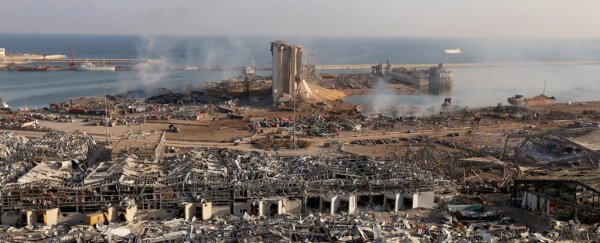An explosion at a port in Beirut brought destruction to the Lebanese capital Tuesday, damaging buildings, killing more than a hundred people, and injuring thousands of others.
People recorded videos showing the blast wave and a towering red cloud that some compared to a nuclear weapon's mushroom cloud.
The exact cause of the blast is unclear, but the focus of an investigation is a warehouse improperly storing 2,750 tons of ammonium nitrate.
The blast registered as a magnitude 3.3 earthquake, and the effects of the explosion were felt miles away from the blast site. Experts told Insider that the blast likely had an explosive yield of several hundred tons of TNT equivalent.
Footage of the massive explosion at #Beirut port a short while ago. It's truly frightening. #Lebanon pic.twitter.com/OZ0hZ5SwlC
— Nader Itayim | نادر ایتیّم (@ncitayim) August 4, 2020
Jeffrey Lewis, a nuclear and conventional weapons expert at the Middlebury Institute of International Studies in California, estimated the yield to be "between 200 and 500 tons, looking at blast damage, the shockwave, seismic signals and the size of the crater."
This video appears to have been shot from the lower rooftop of the Beirut Port Silos.
— Emmanuelle Saliba (@_esaliba) August 4, 2020
This would confirm that the initial blast came from within warehouse 12 and not the silos. https://t.co/I81EkvAihe
That much explosive power is at least two orders of magnitude greater than the GBU-43/B Massive Ordnance Air Blast (nicknamed the "Mother of All Bombs"), the most powerful non-nuclear weapon in the US arsenal with a blast yield of around 11 tons.
The weapon was first used in combat in April 2017 against the Islamic State in Afghanistan.
The explosion in Beirut was so powerful that some observers feared the city had experienced a nuclear detonation of some sort, a fear exacerbated by the mushroom cloud towering over the blast site after the explosion.
The governor of Beirut compared Tuesday's horrific explosion to the atomic bombs that devastated the Japanese cities Hiroshima and Nagasaki during World War II.
"In my life, I haven't seen destruction on this scale," he said.
With an explosive yield of a few hundred tons, the Beirut blast would have been dozens of times less powerful than the atomic bomb that devastated Hiroshima, which had an estimated yield of about 15 kilotons.
The explosive power would, however, be comparable to the lowest yield B61 nuclear gravity bomb, which is believed to have an explosive yield of around 300 tons.
Some experts have estimated the explosive yield for what happened in Beirut to be one to two kilotons, which would make the blast potentially more powerful than some of the smaller US tactical nukes.
"The comparison ends there," Hans Kristensen, a nuclear weaponry expert with the Federation of American Scientists who pointed Insider to unofficial blast yield estimates of a few hundred tons, said of comparing the explosion in Beirut to a nuclear blast.
"The pressure wave would be much faster because the energy release from a uncontrolled nuclear chain reaction is much faster than the energy release from a chemical explosion," he said, further explaining that there would have also been intense radiation, which includes both the prompt radiation from the explosion and the fallout from detonating a nuclear weapon on the ground.
Kingston Rief, a disarmament and threat reduction expert at the Arms Control Association, told Insider that while the explosive yield of the Beirut explosion might be comparable to that of some US nuclear weapons, "this does not at all mean that the explosion would have felt like the detonation of the lowest yield B61 variant."
He argued that a "nuclear explosion would have been far worse, as it would include more extreme thermal and also radiation effects," adding that "nuclear weapons are not just another weapon for a reason."
The ammonium nitrate suspected of triggering the massive explosion that caused widespread destruction for miles and left more than 100 people dead and as many as 5,000 injured was confiscated from a cargo ship several years ago, according to Lebanese officials.
The substance, a common fertiliser, is a highly-explosive material that has been involved in a number of devastating explosions.
For example, a massive 2015 explosion in Tianjin, China that killed more than 160 people, including 99 firefighters, and damaged over 300 buildings was partially caused by 800 tons of ammonium nitrate, and the 1947 Texas City explosion that killed over 500 people involved the detonation of 2,300 tons of the substance.
The destruction in Beirut has left over 300,000 people homeless at a time when the country is struggling both financially and politically.
This article was originally published by Business Insider.
More from Business Insider:
